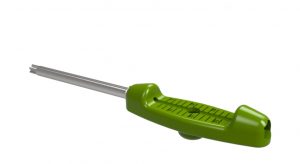In this article we would like to speak about two molding technologies for plastic materials that are very useful for the production of implantable medical devices, but not only.
In fact, in our molding division, we manufacture various components for surgical instruments.
in addition to implantable medical devices.
These two technologies are injection molding and compression molding.
Injection Molding

Injection molding, which is widely used in both the industrial and medical fields, is a process in which the plastic material is melted and injected into a mold.
The injection of the “plasticized” material takes place at high pressures and at equally high temperatures, in order to allow the material to flow inside the machine and, above all, to reach every point of the mold.
With this type of technology we can make both implantable and instrumental components.
Some examples of implantable products made with injection molding technology are:
- PLLA screws
- Peek cage for spine
- peek screws for ligaments
- CFR peek plates (carbon fiber reinforced peek)

PLLA screw (bio and absorbable by the human body material)

CFR peek Plate
Concerning implantable products, molding takes place in ISO 7 rooms. The press dedicated to these components (previous image) is then directly connected to an ISO 5 area where the vacuum packaging process takes place immediately, to preserve the components from external contamination.
Other non-implantable products that can be made with injection molding technology are:
- handles for instruments (multipurpose or disposable)
- test components for instruments
- accessories for instruments

Example of handle for disposable kit
Compression moldig

Compression molding technology differs significantly from injection molding.
Firstly, it is a type of molding which is normally used for thermosetting polymers. The process, consists in compressing the plastic material inside an impression of a heated mold. The heat of the mold fluidifies the thermosetting material which, when compressed by the press, gives shape to the piece. The machines used are also very different. In fact, these are vertical presses (image above).
This technology is very useful when the parts to be produced are relatively simple, geometrically speaking (mostly flat and medium / large in size). The primary use is for implantable devices.
One of the main disadvantages for this technology is the cycle time for each molding, which can be up to a few minutes. To overcome this problem, there is a tendency to make molds with multiple cavities.
In our production site dedicated to plastic molding, it is a widely used technology for the production of a component that is part of an implantable knee device.
This technology was validated decades ago by a major European manufacturer of medical devices, for its precision and for the surface finish of the parts. And it is still used today with good results, despite many years having passed.
For further information and to discover more about our company: https://rebrand.ly/LegheLeggereSEO

